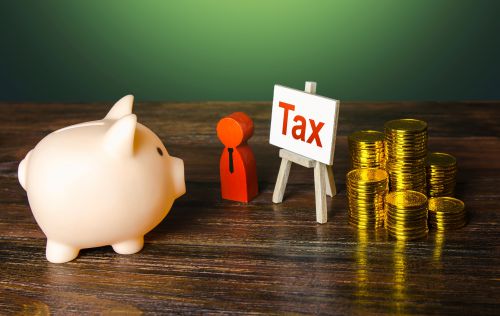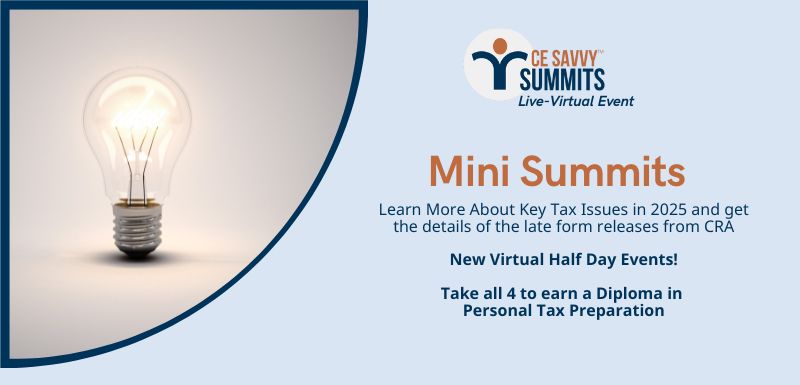T1 Tax Training:Take A Fun Crash Course

Knowledge Bureau is pleased to present the Four-Pack! Four in depth half day virtual Mini-Summits you can access immediately to brush up on your personal tax knowledge in time for tax season 2025!
Start immediately in the comfort and convenience of your home or office. This Four-Pack contains 16 hours of expert recorded instruction by well known tax experts and covers a comprehensive tax filing overview, a focus on capital gains, real estate and small business. Check out the detailed agendas below, then earn your certificate as an updated professional tax practitioner. Register now: Only $995 for the Four-Pack; $395 for individual sessions. Group rates available!
COURSE 1 - CANADA’S INCOME TAX FUNDAMENTALS
About Canada's Digital Tax System
- NETFILE and EFILE: What is the difference?
- EFILERs’ responsibilities
- RepID: Being an Authorized Representative for a client
- My Account and My Business Account
- Filing the T1 & Responding to CRA's Communications
- Tax Credits - Filing for Refundable Tax Credits
Reporting Income
- What is Taxable? What is Not?
- Reporting Income from Employment
- Reporting Income from Pensions
Introduction to Claiming Deductions
- Registered Pension Plan deduction (line 20700).
- Registered Retirement Savings Plans (line 20800).
- First Home Savings Account (line 20805).
- What the split-pension amount and how it works (line 21000).
- Deductions for annual union, professional like dues (line 21200).
- What qualifies as eligible Child Care Expenses (line 20400).
- What qualifies as a Disability Support Deduction (line 20500).
- Calculating moving expenses (line 21900).
- What support payments are deductible from income (line 22000).
- Eligible carrying and interest charges (line 22100).
- What is CPP for self-employed income (line 22200).
- What the CPP is for enhanced contributions on income (line 22215).
- Other employment expenses (line 22900).
- Social Benefits Repayments (line 23500).
Introduction to Non-Refundable Tax Credits
- Basic Personal Amount
- Age Amount
- Spouse or Common-law Partner Amount
- Amount for Eligible Dependant
- Canada Caregiver Amount for Spouse or common-law partner or eligible dependant age 18 or older
- Canada Caregiver Amount other dependants age 18 or older
- Canada Caregiver Amount other dependants under age 18
- Premiums paid to CPP/QPP and EI
- Volunteer Firefights’ Amount
- Search and Rescue Volunteers’ Amount
- Canada Employment Amount
- Home Buyers’ Amount
- Home Accessibility Expenses
- Adoption Expenses
- Digital news subscription expenses
- Pension Income Amount
- Disability Amount
- Tuition Amount
- Interest on Student Loans
- Medical Amount
- Donations and Gifts
Reporting Income from Self-Employment
- The filing deadlines for a taxpayer who reports income from a proprietorship.
- What is the difference between employed and self employed?
- How to report income from micro-businesses in the ‘GIG’ economy, for example:
- Ride Sharing and delivery
- Home based retail services
- Consulting or other “subcontracting services
- How do you complete a basic T2125 Statement Of Business Or Professional Activities?
- How to report the use of an asset in the business on the Capital Cost Allowance Statement?
- How are home office expenses reported?
- How Canada Pension Plan premiums are calculated and where?
- When quarterly tax instalment payments must be made?
- What happens when there is a business loss?
COURSE 2 FOCUS ON CAPITAL GAINS AND LOSSES
Introduction to Capital Gains Reporting
- Overview Schedule 3 – How to Calculate a Capital Gain or Loss
- Capital Gains from Information Slips
- Qualified Small Business Corporation Shares
- Qualified Farm and Fishing Property
- Publicly Traded Shares, Mutual Funds and other shares
- Real Estate, Depreciable Property and Other Properties
- Bonds, Debentures, Promissory notes
- Personal Use Property
- Listed Personal Use Property
Introduction to Reporting Income from Rental Properties
- Form T776 - What is reportable rental income?
- What is the difference between a co-owner and a partner for rental purposes?
- When is it necessary to report rental income?
- What are the types of expenses claimable against rental income?
- What is the difference between a repair and an improvement?
- What are the two main capital classes for reporting improvements?
- Claiming Losses - What are the rental reporting restrictions?
Introduction to Capital Gains Reporting
- Overview Schedule 3 – How to Calculate a Capital Gain or Loss
- Capital Gains from Information Slips
- T2036 Provincial or Territorial Foreign Tax Credit
- T2209 Federal Foreign Tax Credit
- T1135 Foreign Income Verification Statement
Recording Dispositions of Business Properties
- Qualified Small Business Corporation Shares
- Qualified Farm and Fishing Property
- Schedule 3 Losses on Investments in Small Business Corporations and resulting ABIL
Calculations
- T657 Capital Gains Deduction
- T936 Calculation of Cumulative Net Investment Loss (CNIL)
- T691 Calculation of Alternative Minimum Tax
Recording Dispositions of Financial Assets
- Publicly Traded Shares, Mutual Funds and other shares
- Bonds, Debentures, Promissory notes
- Disposition of Employee Stock Options
- T123 Election on Disposition of Canadian Securities
Recording Dispositions of Real Estate and Depreciable Property
- Real Estate, Depreciable Property, Foreclosures, Repossessions
- T776 Rental Income Reporting – Year of Acquisition and CCA Schedules
- T2017 Summary of Reserves on Dispositions of Capital Property
- Vacant Land
- T664 or T664(Seniors), Election to Report a Capital Gain on Property Owned at End of Feb 22, 1994.
- Affect of Capital Gains Inclusion Rates
Recording Dispositions of Personal Use Properties
- Personal Use Property Definition
- T2091 Designation of a Property as a Principal Residence
- Acreages and Farm Property
- T776 Rental Income Reporting and its effects on the PRE
- T1170 Capital Gains on Gifts of Certain Capital Property
- Listed Personal Use Property
Recording Capital Losses and Carry-overs
- Calculating Capital Losses
- T1A Request for Loss Carryback
COURSE 3 - FOCUS ON FAMILIES, RETIREES AND THEIR REAL ESTATE
Deductions for Employment Expenses
- T2200 Declaration of Conditions of Employment
- T777 Statement of Employment Expenses
- TL2 Claim for Board and Lodging
- GST370 – 2014 AND LATER
Deductions for Families
- Understanding Marital Status
- T778 Child Care Expenses
- T1-M Moving Expenses
- T929 Disability Supports Deduction
- T1223 Clergy Residence Deduction
- T2222 Northern Residents Deduction
- RC269 Employee Contributions to a Foreign Pension Plan or Social Security Arrangement for Non-United States Plans or Arrangements
- T2201 Disability Tax Credit
- Interaction of Disability Tax Credit and Medical Expense Claims
- Xe8- Application for Refund of Federal Excise Tax on Gasoline
Families and their Real Estate – The T2091, T1255 and T776
Retirement Income Forms Overview - Accumulating Funds
- T746, Calculating Your Deduction for Refund of Unused RRSP, PRPP, and SPP Contributions
- T1043 Deduction for Excess Registered Pension Plan Transfers from an RRSP, PRPP, SPP or RRIF
- T3012A Tax Deduction Waiver on Refund of Unused RRSP, PRPP, SPP Contributions from RRSP
- T2030 Direct Transfer Under Subparagraph 60(I)(v)
- T2033 Direct Transfer Under Subsection 146.3(14.1), 147.5(21) or 146(21), or Paragraph 146(16)(a) or 146.3(2)(e)
- RC4625 Rollover to a Registered Disability Savings Plan (RDSP) Under Paragraph 60(m)
- T1-OVP-S 2022 Simplified Individual Tax Return for RRSP, PRPP and SPP Excess Contributions
Withdrawing Funds
- T1032 Joint Election to Split Pension Income
- T2205 Amounts from Spousal or Common-law Partner RRSP, RRIF or SPP to Include in Income
- RC339 Individual Return for Certain Taxes for RRSPs, RRIFs, RESPs or RDSPs
- T2157 Direct Transfer from a Registered Plan to Purchase an ALDA
- T1-OVP-ALDA 2022 Individual Tax Return for Excess Transfers to Purchase an ALDA
- T1-OVP-ALDA 2022 Individual Tax Return for Excess Transfers to Purchase an ALDA
- T1136 OAS Return of Income for Non-Residents
T2019 Death of an RRSP Annuitant
- Tax form filing requirements – terminal return
- RC4177 Death of an RRSP Annuitant
- RC4178 Death of a RRIF Annuitant, PRPP Member, or ALDA Annuitant
- T1090, Joint Designation on Death of RRIF Annuitant, PRPP Member of ALDA Annuitant
- RC249, Post-Death Decline in the Value of a RRIF, an Unmatured RRSP and Post-Death Increase or Decline in the Value of a PRPP
- T2075 Election to Defer Payment of Tax
- TX19 Asking for a Clearance Certificate
COURSE 4 - FILING SMALL BUSINESS RETURNS
Tax Planning – The Big Picture - Claiming Income and Losses
- Claiming business losses against other income
- Creating income/losses with CCA and other options provisions
- T1A Loss Carry Back
Form T2125 - Reporting Income from a Business
- T2125 Statement of Business or Professional Activities
- Small Suppliers – No GST
- GST Remitters
Claiming Deductions
- General Rules
- Restricted Expenses: Meals and Entertainment, Home Office, Conventions, Communications Devices, etc.
- Paying Family Members
Claiming Capital Cost Allowance
- General Rules
- Immediate Expensing Rules
- Accelerated investment Incentives
- Automobile Expenses
- Claiming Recapture and Terminal Losses
Filing for Farmers
- T2042, Statement of Farming Activities
- AgriStability and AgriInvest Forms T1163, T1164, T1273, or T1274
- T2043 Return of Fuel Charge Proceeds to Farmers Tax Credit
- Mandatory and Optional Inventory Provisions
- Prescribed Drought Areas – Livestock Tax Deferral
- T2203 Provincial and Territorial Taxes for Multiple Jurisdictions
- Claiming Losses
Filing for Fishers
- T2121 Statement of Fishing Activities
- T1139 Reconciliation of Business Income for Tax Purposes
Tax Remittances and Audits
- CEWS audits and RC683 Refund Verification Programs
Remember: enrol online. Or call for assistance: 1-866-953-4769.
